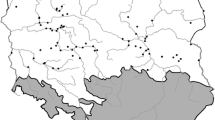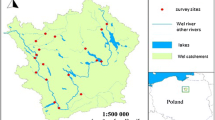Abstract
The species diversity of the entire meta-community is made up of local pools of species of individual communities, including both the totality of actually observed taxonomic groups and species of “dark” diversity, which, by their ecological properties, are theoretically suitable for living in existing conditions and are potentially found during repeated studies. To assess the dark diversity, quantitative indices of suitability of the surveyed areas of the study area are calculated in relation to various taxa of the community under consideration. The study of the species composition of benthic communities was carried out on small and medium lowland rivers, tributaries of the Kuibyshev, Saratov and Volgograd reservoirs, including the rivers of the arid region of the Lake Elton basin. A total of 132 local communities were surveyed, from which 147 taxa of macrozoobenthos were selected for calculations. To highlight the dark diversity, an analysis of the joint occurrence of species was carried out and, using hypergeometric distribution formulas, estimates of the conditional probabilities of the statistical relationship of each of these species with individual sections of the rivers were calculated. Relationships between observed species richness and dark diversity are considered; the occurrence of latent species was tested in sections of rivers of a similar type. The concept of “gray” diversity is introduced, i.e., a subset of observed species, in which the indices of correspondence to the focal area are less than a given threshold.



Similar content being viewed by others
REFERENCES
Akatov, V.V. and Akatova, T.V., Species pool, species richness, density compensation effect, and invasibility of plant communities, Russ. J. Biol. Invasions, 2013, vol. 4, no. 1, pp. 1–11.
Beals, E.W., Bray-Curtis ordination – An effective strategy for analysis of multivariate ecological data, Adv. Ecol. Res., 1984, vol. 14, pp. 1–55.
Bickford, D., Lohman, D.J., Sodhi, N.S., Ng, P.K.L., Meier, R., Winker, K., Ingram, K.K., and Das, I., Cryptic species as a window on diversity and conservation, Trends Ecol. Evol., 2007, vol. 22, no. 3, pp. 148–155.
Carmona, C.P. and Partel, M., Estimating probabilistic site-specific species pools and dark diversity from co-occurrence data, Global Ecology and Biogeography, 2021, vol. 30, no. 1, pp. 316–326.
Cornell, H.V. and Harrison, S.P., What are species pools and when are they important?, Annual Review of Ecology, Evolution, and Systematics, 2014, vol. 45, pp. 45–67.
De Bello, F., Fibich, P., Zelen, D., Kopecký, M., Ak, O.R.M., Chytry, M., Pyšek, P., Wild, J., Michalcov, D., Adlo, S., Smilauer, P., Leps, J., Pärtel, M., and Artel, P., Measuring size and composition of species pools: A comparison of dark diversity estimates, Ecol. Evol., 2016, vol. 6, no. 12, pp. 4088–4101.
Ekologicheskie problemy Verkhnei Volgi (Ecological Problems of the Upper Volga), Kopylov, A.I., Ed., Yaroslavl: Yaroslavsk. Gos. Techn. Univ., 2001.
Eriksson, O., The species-pool hypothesis and plant community diversity, Oikos, 1993, vol. 68, pp. 371–374.
Fujinuma, J. and Pärtel, M., Decomposing dark diversity affinities of species and sites using Bayesian Method: What accounts for absences of species at suitable sites?, Methods in Ecology and Evolution, 2023, pp. 1–12.
Golovatyuk, L.V., Shitikov, V.K., and Zinchenko, T.D., Estimation of the zonal distribution of species of the bottom communities in rivers of the Middle and Lower Volga basins, Povolzhskii Ekologicheskii Zhurnal, 2017, no. 4, pp. 335–345.
Golovatyuk, L.V., Zinchenko, T.D., and Shitikov, V.K., Geographical aspects of spatial distribution of diversity in benthic communities of lotic systems in the Middle and Lower Volga region, Printsipy Ekologii, 2021, no. 2, pp. 38–53.
Klimesova, J. and Klimes, L., Bud banks and their role in vegetative regeneration – A literature review and proposal for simple classification and assessment, Perspectives in Plant Ecology, Evolution and Systematics, 2007, vol. 8, pp. 115–129.
Kubatiev, A., Dzhois (Joyce), Moscow: Molodaya Gvardiya, 2011.
Lewis, R.J., Szava-Kovats, R., and Pärtel, M., Estimating dark diversity and species pools: An empirical assessment of two methods, Methods in Ecology and Evolution, 2015, vol. 7, no. 1, pp. 104–113.
Mirkin, B.M. and Rozenberg, G.S., Fitotsenologiya: Printsipy i metody (Phytocenology: Principles and Methods), Moscow: Nauka, 1978. https://reallib.org/reader?file=818657&pg=214. Cited June 1, 2023.
Moller Pillot, H.K.M. and Buskens, R.F.M., Nederlandse faunistische mededelingen, 1B. De larven der Nederlandse Chironomidae (Diptera), Deel C: Auto-ecologie en verspreiding, Leiden (Nederland): Stichting European Invertebrate Survey – Nederland, Rijksmuseum van Natuurlijke Historie, 1990.
Osobennosti presnovodnykh ekosistem malykh rek Volzhskogo basseina (Features of Freshwater Ecosystems of Small Rivers in the Volga Basin), Rozenberg, G.S. and Zinchenko, T.D., Eds., Tolyatti: Kassandra, 2011.
Ovaskainen, O. and Abrego, N., Species Distribution Modelling: With Applications in R, Cambridge: Cambridge University Press, 2020.
Pärtel, M., Szava-Kovats, R., and Zobel, M., Community completeness: Linking local and dark diversity within the species pool concept, Folia Geobotanica, 2013, vol. 48, no. 3, pp. 307–317.
Rozenberg, G.S., Shitikov, V.K., and Zinchenko, T.D., Mark Vellend. The Theory of Ecological Communities. Princeton; Oxford: Princeton Univ. Press. 2016. 229 p., Zh. Obshch. Biol., 2020, vol. 81, no. 5, pp. 394–400.
Shitikov, V.K., Zinchenko, T.D., and Golovatyuk, L.V., Models of joint distribution of species with benthic communitiesfrom the small rivers of the Volga basin as a case study, Zh. Obshch. Biol., 2021, vol. 82, no. 2, pp. 143–154.
Shitikov, V.K., Zinchenko, T.D., and Rozenberg, G.S., Makroekologiya rechnyh soobshchestv: koncepcii, metody, modeli (Macroecology of River Communities: Concepts, Methods, Models), Tolyatti: Kassandra, 2011. http://www.ievbras.ru/ecostat/Kiril/Library/B0_cont. htm. Cited June 1, 2023.
Silvertown, J., Dodd, M., Gowing, D., Lawson, C., and McConway, K., Phylogeny and the hierarchical organization of plant diversity, Ecology, 2006, vol. 87, pp. 39–49.
Veech, J.A., A probabilistic model for analyzing species co-occurrence, Global Ecology and Biogeography, 2013, vol. 22, no. 2, pp. 252–260.
Zinchenko, T.D., Ekologo-faunisticheskaya harakteristika hironomid (Diptera, Chironomidae) malyh rek bassejna Srednej i Nizhnej Volgi (Atlas) (Ecological and Faunal Characteristics of Chironomids (Diptera, Chironomidae) in Small Rivers in the Basin of the Middle and Lower Volga (Atlas)), Tol’yatti: Kassandra, 2011. http://www.ievbras.ru/books/books.html. Cited June 1, 2023.
Zinchenko, T.D., Shitikov, V.K., Golovatyuk, L.V. et al. Plankton and bottom communities in the saline rivers of Lake Elton basin: Statistical analysis of dependences, Arid Ecosyst., 2018, vol. 8, no. 3, pp. 225–230.
Zobel, M., The species pool concept as a framework for studying patterns of plant diversity, Journal of Vegetation Science, 2016, vol. 27, pp. 8–18.
Funding
The work was carried out on the subject of research work Change, sustainability and conservation of biological diversity under the influence of global climate change and intense anthropogenic pressure on the ecosystems of the Volga basin. Registration number of the state task 1021060107212-5-1.6.20; 1.6.19 and with the financial support of the Russian Foundation for Basic Research, grant No. 17-04-00135 “Functional features of the organization of the structure of planktonic and benthic communities of river ecosystems on the example of saline rivers in the basin of the hypersaline Lake Elton.
Author information
Authors and Affiliations
Corresponding author
Ethics declarations
Conflict of interests. The authors declare that they have no conflicts of interest.
Rights and permissions
About this article
Cite this article
Zinchenko, T.D., Shitikov, V.K. & Rosenberg, G.S. Assessment of Bottom River Communities in Considering the “Dark and Gray Diversity” of Species: Approaches to a Solution. Arid Ecosyst 13, 527–534 (2023). https://doi.org/10.1134/S2079096123040200
Received:
Revised:
Accepted:
Published:
Issue Date:
DOI: https://doi.org/10.1134/S2079096123040200




